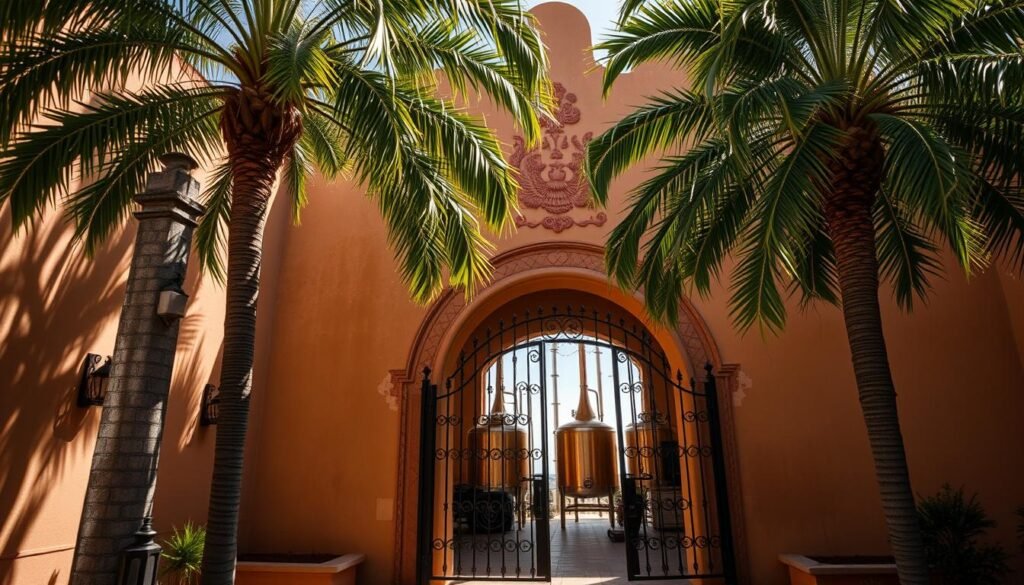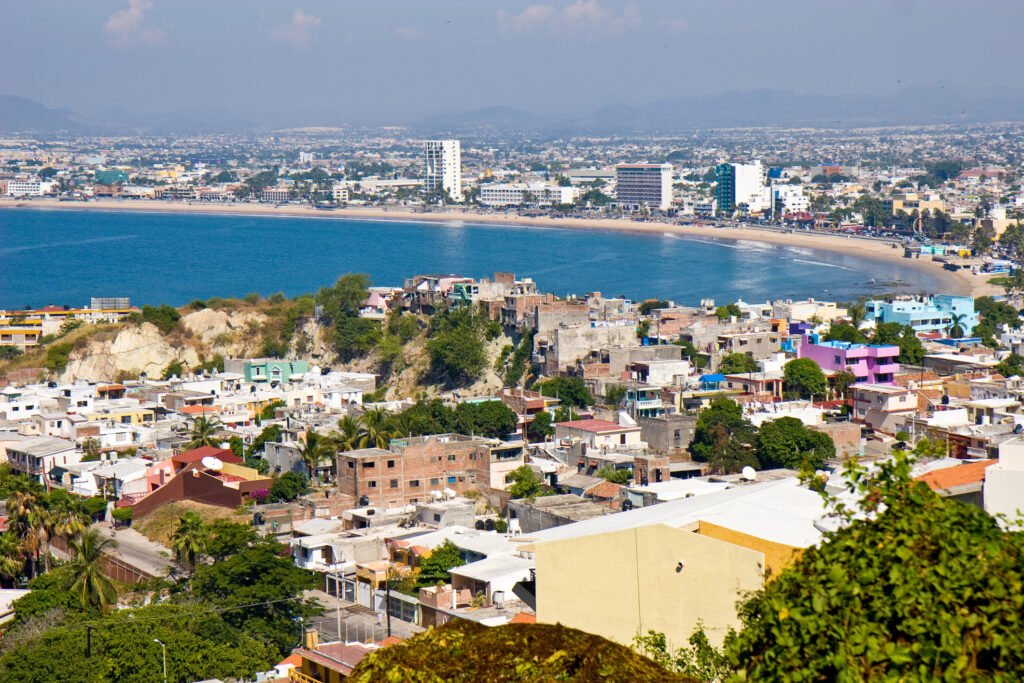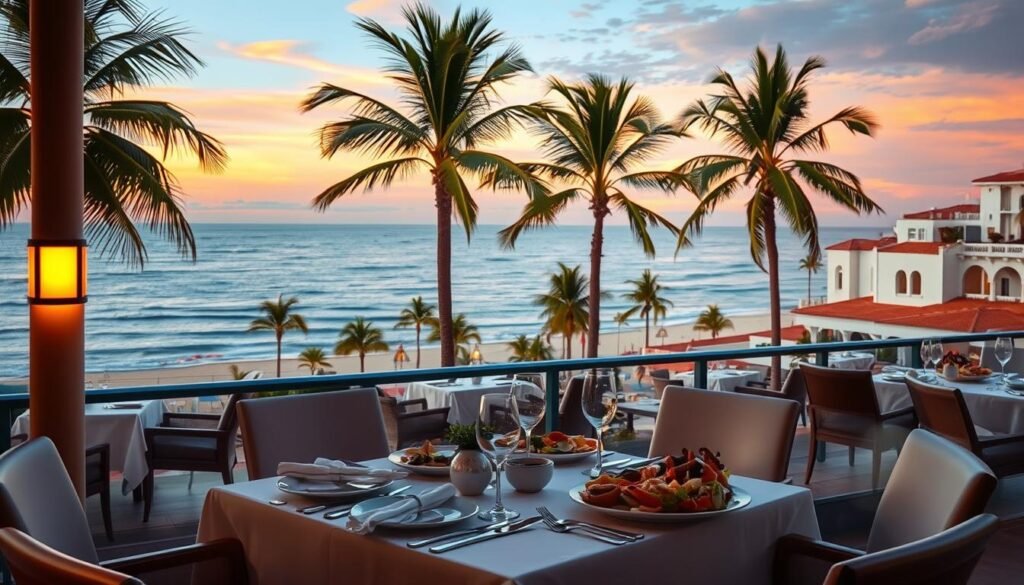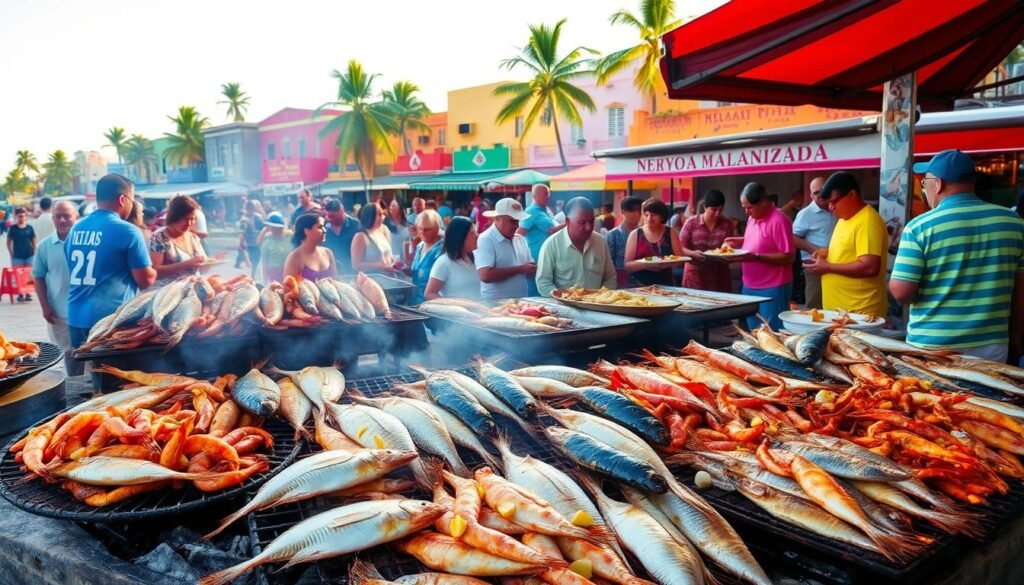Walking the Malecón’s sunbaked promenade, the scent of salt air mixes with wood-fired smoke. That’s when I first tasted Pacifico’s crisp citrus finish paired with Pescado Zarandeado. This whole fish is kissed by charcoal flames, its skin caramelized over mesquite. This experience in Mazatlán goes beyond menus, blending ocean and tradition.
The Pacific waves whisper through every bite of this coastal city’s food culture. Fishermen’s boats dock near Mercado Pino Suárez, where vendors prepare marinades with garlic, chiles, and citrus. Every sip of Pacifico and every flake of tender pescado tells a story of place. Here, Mexico’s Pacific coast flavors meet the warmth of a culture that celebrates life through food.
Key Takeaways
- Pacifico’s light body balances perfectly with the smoky heat of Pescado Zarandeado
- Mazatlán’s food culture blends indigenous, Spanish, and Afro-Caribbean influences into its seafood traditions
- Sinaloa cuisine prioritizes freshness, using ingredients like aguachile and tamales de elote straight from the coast
- Authentic Mexican seafood experiences thrive in beachside palapas where locals gather at dusk
- Culinary travel to Mazatlán reveals a destination where every meal honors centuries-old fishing and cooking techniques
A Taste of Mexico’s Pacific Pearl: Mazatlán’s Culinary Identity
Walking along Mazatlán’s Malecón, the salty breeze carries the scent of grilled ceviche and sizzling fish. This is where the city’s culinary identity unfolds—a tapestry woven from the sea and centuries of tradition. The coastal Mexican food here tells a story of waves meeting land, where every dish whispers of the Pacific’s bounty.
The Coastal Influence on Local Gastronomy
Freshly caught mahi-mahi glistens on open-air grills, its citrus-marinated flesh capturing the essence of Mexican Pacific cuisine. Coastal kitchens prioritize simplicity: raw shrimp ceviche brightened with serrano chiles, or chilorio pork simmered in dried chiles and orange juice. Fishermen’s traditions live in dishes like caldo de mariscos, a broth thick with crab and octopus, proof that the ocean’s pulse defines this region’s palate.
Indigenous and Spanish Roots in Sinaloan Cuisine
Maize and nopal cactus pads from pre-Hispanic times appear in dishes like sopes de camarones. Spanish-era techniques like adobo pastes layered onto grilled meats. The Sinaloan food history is a dialogue between mesquite-smoked chapulines and pork tacos glazed with pineapple salsa. Local markets sell wild herbs like epazote beside Castilian-style cheese wheels—a fusion that shaped the region’s soul.
The Rhythm of Mazatlán’s Food Culture
Days begin with pan de queso crusty buns sold by women in rebozos, while nights hum with palapa bars serving aguachile. The city’s culinary heartbeat thrums in its Mazatlán culinary identity: fish stalls open at dawn, taco trucks park beside colonial plazas, and families gather at midnight. Epicurean Escape’s guides reveal hidden spots where tortilleras hand-press corn tortillas. Every meal here is a living archive of its people’s journey.
The Story Behind Pacifico Beer: Mazatlán’s Iconic Cerveza

Walking through Cervecería del Pacífico’s sunlit halls, I felt the weight of over a century of brewing tradition. Founded in 1900 by German immigrants, Pacifico beer history is etched into every fermentation tank. The brewery’s signature lighthouse logo, inspired by Mazatlán’s harbor, now graces taprooms from coastal cantinas to global tables.
Here, the Mazatlán breweries legacy begins with water drawn from local springs. Their mineral-rich flow shapes Pacifico’s crisp, mineral-forward taste.
“This isn’t just beer—it’s a dialogue between land and craft,” a brewmaster shared as we sampled unfiltered batches. The Mexican craft beer revolution now sees modern brewers reinterpreting Pacifico’s DNA. They blend ancestral techniques with innovation.
The malty backbone and citrus kiss in every sip mirror the city’s duality: timeless yet ever-evolving.
For travelers, Cervecería del Pacífico offers tours revealing how tradition endures. Its story intertwines with Mazatlán’s pulse—every pour a toast to the Pacific Ocean’s influence and the hands that brew its liquid legacy. Discover more at Epicurean Escape’s cultural journeys, where the art of brewing becomes a sensory narrative.
From Ocean to Grill: The Art of Pescado Zarandeado
As dawn breaks over Sinaloa’s shores, I learned about Pescado Zarandeado. It starts long before the grill’s smoke rises. Fishermen gut and butterfly snapper or mahi-mahi, preparing them for even char.
The Mazatlán signature dish is a ritual. Fillets are marinated and grilled on a zaranda rack over mangrove charcoal. This tool is as old as the dish itself.
Traditional Preparation Method
Every bite tells a story. The fish, cool from the sea, is slit open and flattened. It’s ready to soak up the marinade’s flavors.
Grilled slowly over mangle wood, the fish gets a smoky taste. Locals love this smokiness as much as the Sinaloa seafood specialties. Each family has its own secret marinade, like orange blossom water or smoked paprika.
The Secret Behind the Perfect Marinade
- Charred garlic and dried guajillo chiles form the base
- Lime juice from nearby orchards cuts through the fish’s richness
- Annatto seeds (achiote) lend their rusty-red hue and earthy warmth
One modern riff adds pineapple salsa to the marinade. But purists prefer simplicity. “The fish itself must sing,” Dona Elena of La Cazuela said, brushing oil over the griddle.
Her hands moved with the precision of a chef who’s perfected this dance over decades.
Where Locals Go for the Best Pescado Zarandeado
In the Golden Zone, El Farallón’s seaside palapa serves plate after plate. But for its soul, go to Stone Island at low tide. Fishermen grill over open flames and sell ceviche from buckets.
The smoky aroma alone is worth the journey.
Culinary Travel to Mazatlán: What Food Enthuasiasts Need to Know
Planning a trip to Mazatlán? Let me share the insider’s playbook for savoring its culinary soul. Every visit to this coastal gem offers distinct flavors depending on the season.
Best Seasons for Unforgettable Flavors
The best time to visit Mazatlán hinges on what you crave. Summer’s heat brings mangoes dripping with sweetness; autumn’s seas yield plump shrimp for Pescado Zarandeado. Time your visit to festivals like Fiesta de la Tuna, where cactus paddles star in inventive dishes. The shoulder seasons—April or November—offer fewer crowds but abundant seafood.
Navigating Local Food Markets

Overlooking Mazatlan Mexico. A Spectacular View Of Mazatlan Bay
“In the market, freshness is everything. Ask ‘¿Qué está fresco hoy?’ (What’s fresh today?) to find the best catches,” says Doña Rosa, a vendor at Mercado Pino Suárez.
- Start at Mercado Pino Suárez at dawn to see fishmongers displaying camarones (shrimp) and cojinua (stingray).
- Follow your nose to stalls selling nopales (cactus) or sample street tamales wrapped in banana leaves.
- Learn to barter with vendors: “¿Podría darme una muestra?” (Could I get a sample?) builds rapport.
Speaking the Language of the Plate
Mastery of a few Spanish food vocabulary phrases unlocks deeper connections. Try:
- “Sin picante, por favor” (No spice, please) to tame fiery dishes.
- “¿Cómo se prepara este platillo?” (How is this dish prepared?) to uncover cooking methods.
- “Quiero probar algo auténtico” (I want to try something authentic) to bypass tourist menus.
Pair these phrases with curiosity—the locals adore sharing stories behind their cuisine.
For tailored itineraries blending Mazatlán food tourism and hidden eateries, explore our Epicurean Escape’s guide. Every bite here tells a story waiting to be tasted.
Beyond the Classics: Hidden Gems of Mazatlán’s Food Scene
My search for Mazatlán’s best flavors started early, in a quiet alley. The smell of lime and chili led me to undiscovered Mazatlán restaurants. These places are hidden from most tourists, where authentic Sinaloan dishes are served in simple settings.
At Doña Rosa’s, fishermen grill pescado a la talla over mesquite. It’s a beachside spot where the food is unforgettable. And at midnight, local Mexican street food carts pop up, serving camarones cucaracha in banana leaf wrappers.
| Dish | Flavor Profile | Where to Find |
|---|---|---|
| Pescado a la talla | Crispy skin, smoky flesh, citrus-marinated | Playa Camaronera’s dawn grills |
| Camarones cucaracha | Sweet shrimp coated in masa, crispy, garlicky | La Noche de la Luna Llena carts (full moon nights) |
| Tamales barbones | Shrimp-stuffed banana leaf tamales | La Abuelita’s kitchen (by reservation only) |
“The best meals are found where the locals linger—not the menus,” said Javier, my fisherman-turned-guide.
These undiscovered Mazatlán restaurants are all about tradition. They serve dishes like chilorio pork and aguachile made with backyard chilies. To enjoy these, follow the city’s rhythm. Ask locals about their favorite local Mexican street food spots or join authentic Sinaloan dishes events in colonia neighborhoods.
Doing so, you’ll taste flavors untouched by tourists. Every bite is like a secret shared with you.
The Marriage of Pacifico and Seafood: Perfect Pairings
There’s a special magic when . It’s not just about taste; it’s a celebration of where the food comes from. Try Pacifico with grilled fish tacos or octopus zarandeado. The beer’s crisp taste and clean finish complement the seafood perfectly.
At Mexican beer tasting events, experts show how Pacifico pairs well with spicy dishes like camarones culichi. The beer’s crispness cleanses your palate, balancing out rich sauces.
Beer Tasting Notes for Culinary Travelers
- Pacifico’s light body and sweetness make ceviche even fresher without overpowering it.
- Its 4.0% ABV is perfect for pairing with delicate seafood, never overpowering it.
- Locals say the beer is best chilled to 4°C, ideal for spicy aguachiles.
Local Dishes That Complement Pacifico’s Crisp Profile
Pair Pacifico with machaca de pescado (dried fish salad) for a fun texture contrast. Or, let it enhance the creamy coconut broth of tortilla de camaron. The Pacifico beer food pairing tradition in Mazatlán is all about sharing and connection.
As the sun sets, people gather at palapas for micheladas—a tangy beer cocktail. This culinary ritual is more than just drinking; it’s a way to enjoy coastal life.
From Street Carts to Fine Dining: Where to Eat in Mazatlán
Walking through Mercado Pino Suárez is like entering Mazatlán’s food heart. The market is alive with flavors: chorizo tacos at La Tapatía, aguachile at El Rinconcito de Doña Chon, and cajeta churros. These dishes are made by families who have passed down their recipes for years.

For a meal by the ocean, visit La Catedral or El Farallón. Pick your fish from the day’s catch. Then, watch it cook over mesquite wood as the sea breeze carries the smell of grilled citrus. These places offer simple yet stunning views.
In Mazatlán, best restaurants like La Cevichería 28 and Mar y Tierra mix tradition with new ideas. At Mar y Tierra, try their shrimp ceviche with burnt lime foam. It’s a modern twist on Sinaloan flavors. These kitchens show that old and new can go hand in hand.
- Mercado Pino Suárez: Breakfast at La Chonita for crispy chilaquiles with Oaxaca cheese
- Palapas: Sunset cocktails at El Farallón with fresh oyster tostadas
- Contemporary dining: Tasting menus at La Casona that pair Pacifico beer with blackened octopus
In Mazatlán, you can enjoy street corn or wine at a cliffside. The city’s food scene invites you to discover its rich flavors without any fuss.
The Ritual of Dining: Understanding Mazatlán’s Food Culture
My first morning in Mazatlán started with café con leche and pan de coco at a family taquería. Here, Mexican dining customs felt like a slow dance. Meals are more than food; they’re stories shared together.

Locals enjoy the relaxed Mexican mealtime rituals, starting with almuerzo. This late brunch turns into lunch. By midday, grilled fish sizzles at palapas, where Sinaloan eating habits mean plates are always full. A host’s joy is in filling your tortilla until you say “ya basta”.
- Chiltepin salsa starts every meal, a spicy kick.
- Callo de lobina ceviche is made right at your table, balancing sea and acidity.
- Sobremesa is the long chat after eating, where time stands stil.
At a home-cooked comida, my hostess said, “Food is a verb, not a noun.” The sounds of ollas and laughter show Mazatlán food traditions as a living legacy. Joining in is to connect with generations.
Respect the pace: don’t rush, enjoy sobremesa, and accept every dish. These customs are the heart of a community, making every meal a shared memory.
How Mazatlán’s Culinary Scene Is Evolving While Preserving Tradition
Walking through Mazatlán’s markets, I saw a quiet change. Chefs and fisherfolk are updating their dishes while keeping their roots. This mix of culinary preservation and evolving Mexican cuisine is seen in every meal, from street food to fancy restaurants.
Modern Chefs Championing Local Ingredients
Young chefs at Epicurean Escape are making old favorites new again. They use farm-to-table Mazatlán ingredients. This blend of old and new makes every dish special.
The zesty tuna with mango salsa I tried was a perfect example. It showed how evolving Mexican cuisine stays true to its roots while exploring new flavors.
Sethics in the Sea
Local groups are leading the way in sustainable seafood Mexico. Fishermen told me about their efforts to fish responsibly. This way, they ensure the sea’s bounty for the future.
Restaurants like La Punta Grill show their commitment by displaying eco-friendly certifications. This move is not just good for the planet—it’s a promise to the next generation.
Tourism’s Double Edge
More visitors mean more demand for real, local food. But, it also risks changing the flavors. Chefs are now teaching recipes to keep dishes like chilorio alive.
“We want to keep these traditions alive,” said Dona Maria, a culinary historian. “But we also need to adapt to new tastes.”
Mazatlán finds a perfect balance between tradition and innovation. Every dish here tells a story of strength and creativity. The Pacific’s flavors are preserved, but now they also hint at the future.
Conclusion: Why Mazatlán Deserves a Place on Every Food Lover’s Bucket List
Imagine biting into pescado zarandeado, its caramelized crust giving way to tender fish, paired with a chilled Pacifico. This moment captures Mazatlán’s essence: a place where the ocean and tradition meet. As someone who has explored Mercado Pino Suárez and enjoyed cerveza under palapas, I’ve seen Sinaloa’s food culture. It’s shaped by fertile valleys and vibrant fishing ports.
Every dish here tells a story—a mix of indigenous, Spanish, and coastal influences. This blend defines Mexican food travel at its most genuine. Mazatlán stands out for its balance of tradition and innovation. Locals prepare fish in chiles and citrus, while modern chefs update classics without losing their essence.
The city’s dedication to sustainable seafood and farm-to-table practices keeps traditions alive. From the market’s chaos at dawn to beachside meals at sunset, every bite is a true experience. It’s not just eating; it’s a conversation with history and community.
For those seeking more than tourist fare, Mazatlán offers a peek into Mexico’s coastal heart. Its status as a culinary destination comes from its genuine flavors, forged over generations. When you sip Pacifico at a palapa, you’re celebrating Sinaloan pride. This is where Mexican food travel becomes a journey to the heart of Mexico’s culinary soul.


